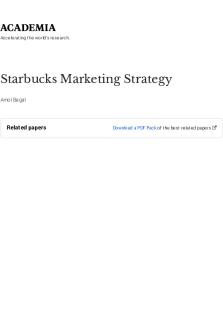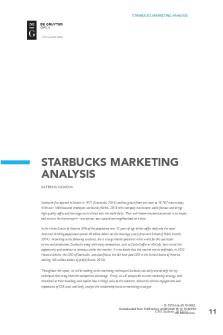Starbucks Marketing Analysis 01-03 PDF

| Title | Starbucks Marketing Analysis 01-03 |
|---|---|
| Author | Ahmed Ahmed |
| Course | Marketing Research |
| Institution | جامعة المنصورة |
| Pages | 3 |
| File Size | 189.8 KB |
| File Type | |
| Total Downloads | 113 |
| Total Views | 167 |
Summary
Marketing research about StarBucks...
Description
STARBUCKS MARKETING ANALYSIS
10.1515/cris-2015-0002
STARBUCKS MARKETING ANALYSIS KATERINA HASKOVA
Starbucks first opened in Seattle in 1971 (Starbucks, 2014) and has grown from one store to 19,767 stores today. With over 160 thousand employees worldwide (Forbes, 2013) this company has become world famous and brings high quality coffee and beverages to its clients over the world daily. Their well-known mission statements is: to inspire and nurture the human spirit – one person, one cup and one neighborhood at a time. In the Unites States of America 54% of the population over 18 years of age drinks coffee daily and the total American drinking population spends 40 billion dollars on this beverage yearly (Harvard School of Public Health, 2014). According to the following statistics, there is large market potential in the world for this particular service and production; Starbucks along with many competitors, such as Costa Coffee or McCafe, have seized this opportunity and continue to innovate within this market. It is no doubt that this market can be profitable; in 2012 Howard Schultz, the CEO of Starbucks, was classified as the 8th best-paid CEO in the United States of America making 103 million dollars of profit (Rushe, 2013). Throughout this report, we will be looking at the marketing techniques Starbucks uses daily and identify the key techniques that bring them the competitive advantage. Firstly, we will analyse the current marketing strategy, look into detail at their branding, and explain how it brings value to the customer, discuss the ethical engagements and importance of CSR used, and lastly, analyse the relationship between marketing strategies.
- 10.1515/cris-2015-0002 Downloaded from PubFactory at 08/03/2016 12:10:46PM CRIS Bulletin via 2015/01 free access
11
STARBUCKS MARKETING ANALYSIS
1. STARBUCKS' CURRENT MARKETING STRATEGY
Every business needs to carry out a successful marketing strategy in order to be noticed by consumers and to forge brand identity. Throughout this section, Starbucks' marketing strategy will be described using the core marketing strategy concept, identifying the positioning and marketing mix, and analysing the environment in which it operates. Strategic marketing will further be used in complement with tools such as the Ansoff and BCG Matrix. CORE MARKETING STRATEGY A core marketing strategy analysis looks at segmentation, targeting, positioning, and differentiation. This type of analysis allows the company to understand the type of service they want to provide, which product type they are selling and to whom. SEGMENTATION At Starbucks, the demographic segmentation's main group is between 25 and 40 years of age with high incomes, the second target group is 18 to 24 year of age and belongs to richer families. In general, the customers belong to the Generation Y born between 1977 and 2000; this is where most profit is made as claimed by Fromm (2014). Psychographic segmentation indicates that customers belong to the upper-middle class and generally have college education (Rafii, 2013). When targeting, Starbucks is situated between mass marketing and segment marketing; they are targeting a broader public; however, there are some criteria that the customers should have, such as higher incomes or a younger age. We can illustrate Starbuck's positioning thanks to the graph (Zapolski, 2010) below; it is how the customers perceive the product and service sold.
Figure 1: Starbuck's Positioning
12
CRIS Bulletin 2015/01
- 10.1515/cris-2015-0002 Downloaded from PubFactory at 08/03/2016 12:10:46PM via free access
© kritchanut/123RF.COM STARBUCKS' POSITIONING As Blankson and Kalafatis (2007) point out in the Journal of Services marketing, positioning has received little attention from marketers but is very useful in defining and modifying the tangible characteristics of the product and its intangible perceptions. At Starbucks, customers are buying an expensive product of high quality (tangible), but they also have the personalised in-store experience enhanced by the trained employees, for example, the customer's name is written on the plastic cup their beverage will be served in (intangible); this helps Starbucks obtain the premium brand status and fight competition. The unique selling proposition concept helps Starbucks differentiate their products and services and gain competitive advantage over competition. Starbucks is known for their good customer service and in-store experience, for customers can either spend some time in the shop and benefit from the friendly and cozy environment and Wi-Fi, or they can rapidly purchase their beverage and continue on their way. In both cases the customer is meant to take away a unique experience. This unique selling concept is especially important in a fast moving world where technology is becoming more personalised and where social interactions are decreasing; the customers can find some human contact in their everyday lives in a Starbucks store. Despite what Moore (2006) explains by claiming that Starbucks is by far the leader in the industry they have created; there are several criticisms facing Starbucks about their individual approach to customers. Sanburn (2012) explains that in 2010, when Starbucks opened several new stores, the company lost "some of its magic" and the individual service was not so personal anymore. Customers felt neglected and treated as a regular fast food customer, and this contradicts the unique selling proposition the company had laid out earlier during its creation and decreases the competitive advantage Starbucks detains over their competitors.
- 10.1515/cris-2015-0002 Downloaded from PubFactory at 08/03/2016 12:10:46PM CRIS Bulletin via 2015/01 free access
13...
Similar Free PDFs

Marketing Strategies - Starbucks
- 11 Pages

Starbucks Marketing Strategy
- 18 Pages

Starbucks Marketing Plan
- 28 Pages

Starbucks Strategic Marketing Plan
- 33 Pages

Starbucks case analysis
- 17 Pages

Case Analysis Starbucks
- 11 Pages

Starbucks Strategic Analysis R
- 98 Pages

Starbucks Financial Analysis
- 34 Pages

Starbucks SWOT Analysis
- 2 Pages

Marketing Analysis
- 50 Pages

Starbucks
- 8 Pages
Popular Institutions
- Tinajero National High School - Annex
- Politeknik Caltex Riau
- Yokohama City University
- SGT University
- University of Al-Qadisiyah
- Divine Word College of Vigan
- Techniek College Rotterdam
- Universidade de Santiago
- Universiti Teknologi MARA Cawangan Johor Kampus Pasir Gudang
- Poltekkes Kemenkes Yogyakarta
- Baguio City National High School
- Colegio san marcos
- preparatoria uno
- Centro de Bachillerato Tecnológico Industrial y de Servicios No. 107
- Dalian Maritime University
- Quang Trung Secondary School
- Colegio Tecnológico en Informática
- Corporación Regional de Educación Superior
- Grupo CEDVA
- Dar Al Uloom University
- Centro de Estudios Preuniversitarios de la Universidad Nacional de Ingeniería
- 上智大学
- Aakash International School, Nuna Majara
- San Felipe Neri Catholic School
- Kang Chiao International School - New Taipei City
- Misamis Occidental National High School
- Institución Educativa Escuela Normal Juan Ladrilleros
- Kolehiyo ng Pantukan
- Batanes State College
- Instituto Continental
- Sekolah Menengah Kejuruan Kesehatan Kaltara (Tarakan)
- Colegio de La Inmaculada Concepcion - Cebu




